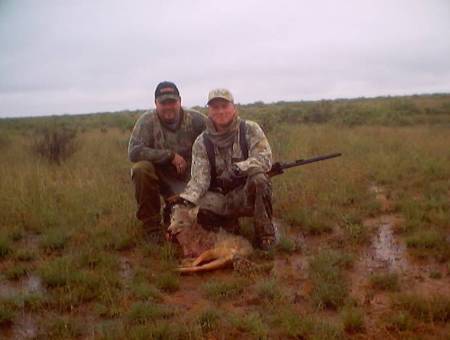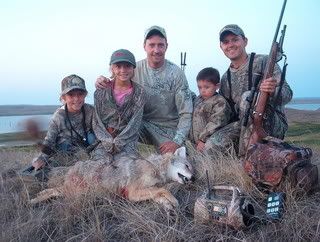Counting Coyotes: Quantity of Coyotes or Quality of the Hunt?
Most hunters would agree that success comes slow and can be, at first, frustrating. I have always thought it odd that most video or TV shows on hunting will depict someone standing over a dead animal saying, "It doesn't get any better than this," or "This is what it's all about." It seems to reinforce the idea that the end justifies the means. Any success I have had in the field can be contributed to scouting, patterning, and hunting accordingly. Anytime two hunters meet, hunting stories begin to loom large--not unlike fishing stories. Increasingly, though, it is getting difficult to separate genuine hunters from "hunter wannabe's?. Sometimes, hearing a whopper is truly impressive, but other times, hearing one is downright frustrating.
Last fall while out hunting, one of these "coyote hunters" wanted to show me the coyotes and fox he had in the back of his truck. We talked for a while about coyote hunting and then about the equipment he was using. He said he had shot 97 coyotes between the first week of September and Thanksgiving. At first, I thought it was possible if he was trapping and snaring along with the calling but when he said that he had a full time job and it wasn?t predator control and didn?t know how to trap or snare. Well I thought possible but not likely. When I returned to my motel room, I told the story to my brother and we did the math. If you hunt three days per week for eleven weeks, average ten stands per day, call in one coyote for every three stands, and manage to kill 90% of the coyotes you bring in, you'll be up to the 100 mark by Thanksgiving easily. Maybe it's not impossible if you have good weather and a high population of coyotes on your side. But hunting east of the Missouri in North Dakota it's still highly unlikely. When I told this story to a rancher whose land I have been hunting for years, he told me that he caught the same man several times running his pasture in a pick-up and has been causing problems with some other ranchers. Obviously, this "coyote hunter" is more concerned about putting up numbers than having a good hunt. Getting the most by driving around pastures, calling from the truck, and hoping to get a coyote on the run is not in my opinion coyote hunting. An easy way to rack up the numbers maybe, but not respectable.
I asked one old predator-hunter how many coyotes he had shot during the past winter. He said he would not be lying if he told me five. His answer puzzled me because I knew he did a fair amount of coyote hunting with snares, traps, decoy dogs, and just plain calling. I pressed him to tell me the truth. He smiled and said it was closer to 80, which makes more sense considering he earns his way impart to predator control for sheep ranchers. He explained that usually when he tells people what he gets, they either don't believe him or else they killed more by Christmas than he had seen all year. Though, naturally, there is always someone with a bigger and better story.
"How many?" may be the most popular question hunters and trappers ask one another, but it wouldn't hurt to ask, "Where were you hunting?" and "How often did you get out?" and "What were you using?" If you don't work winters and are living in a place like Southern Arizona, an area with a high density of coyotes, you will undoubtedly have more opportunities to put up fur than someone who works winters and who lives in a large metropolitan area. Who is the better or more successful hunter--the first one, who may get fifty coyote, or the latter one, who may get fifteen? It's a hard question to answer, but it seems quantity often overshadows the quality of the hunt.
For me, success has always been in the details. If you judge hunters' ability based on the number of animals shot, then we should all gas up a truck, grab the business band radio, get some dogs and four-wheelers and run the coyotes to death. Then crack a beer, pound our chests, and call ourselves predator-hunters. Hunters often see tracks from snowmobiles, four-wheelers, and pick-ups in pastures and fields around rock piles and cattail sloughs. Later, they hear "coyote hunters" brag about all the critters they shot. The true coyote hunters, though, spent all day calling only to smoke one coyote they walked a mile off the road for, with snow up to their knees, and to call with in 75 yards without the song dog knowing what hit him.
With coyote hunting these days there are getting to be too many "coyote hunters" sitting in pick-ups with speakers out their windows. It makes me angry, but when I hear what seems like another far-fetched tale, I still try to listen and be polite. If you have been hunting long enough, you are bound to have a breakout day or a season that goes perfectly. A friend and I once even called in ten coyotes by noon one Sunday in late February. It turned out to be a great day for hunting coyotes with a slight Northwest breeze and an overcast sky in western North Dakota. And it was a bit unusual, especially that late in the season--but everything just clicked. Telling a whopper is something hunters and anglers alike enjoy telling, especially if it's true. But trying to pass off using a pick-up to kill a lot of coyotes as hunting is less than admirable, it's wrong.
There are no short cuts to becoming an ethical and efficient predator hunter. The reward and satisfaction for hunting is not in the numbers, but in the hunt itself. Be proud of each hunt and all that goes into it.

